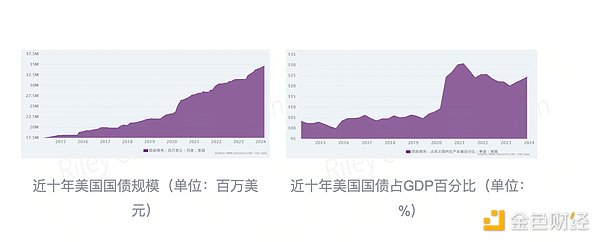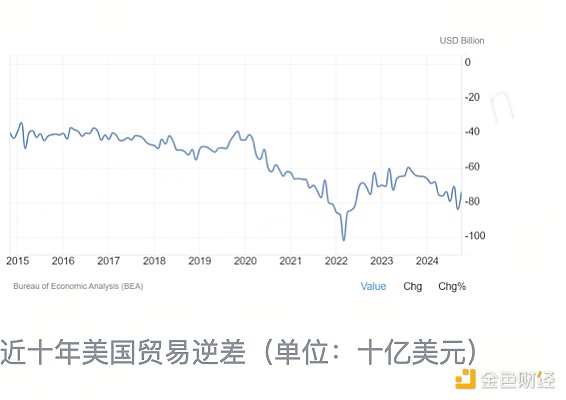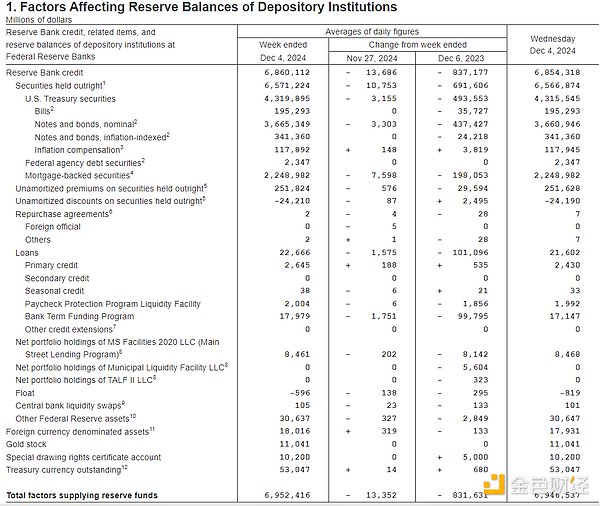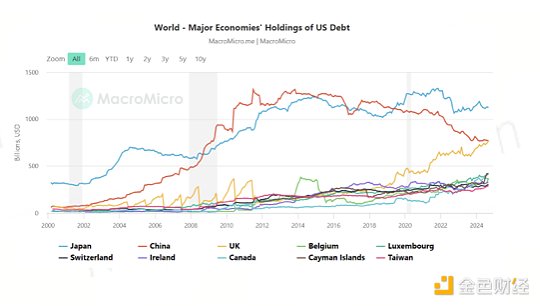Author: Jeffrey Ding, Chief Analyst of HashKey Group
Introduction
At the beginning of the new year, the scale of US national debt has exceeded 36.4 trillion US dollars. How to resolve the US debt crisis, can the international hegemony of the US dollar continue? How will Bitcoin react, and how will the international settlement unit be replaced in the future?
We will start with the US debt economic model, and then discuss the debt risks currently faced by the internationalization of the US dollar, and analyze whether the US debt repayment plan is feasible. Looking back at the past and present, let's see where US debt points Bitcoin.
Establishment of the US debt economic model
After the collapse of the Bretton Woods system, the US dollar hegemony grew arbitrarily on the debt economic model.
The Bretton Woods system collapsed, and the US dollar became a credit currency
After World War II, the Bretton Woods system was established, the US dollar was linked to gold, the International Monetary Fund (IMF) and the World Bank controlled the relevant rules, and an international monetary system centered on the US dollar was formed. However, the famous "Triffin Dilemma" accurately predicted the collapse of the Bretton Woods system: the demand for international settlement continued to grow, the US dollar continued to flow out of the United States and settle overseas, and the United States had a long-term trade deficit; and the US dollar, as an international currency, must maintain a stable currency value, which in turn requires the United States to have a long-term trade surplus. In addition, the Vietnam War exacerbated the double deficit. In 1971, President Nixon announced that the US dollar was decoupled from gold. The US dollar was transformed from a standard currency to a credit currency. Its value was no longer guaranteed by precious metals, but by the national credit of the United States.
Debt economic model established, dollar hegemony continued
On this basis, the debt economic model of the United States was established: global trade is settled in US dollars, and the United States must maintain a huge trade deficit so that other countries can obtain a large amount of US dollars; countries around the world purchase US Treasury bonds to maintain and increase the value of the US dollar, and then invest in US financial products to make the US dollar flow back to the United States.
As the world currency, the US dollar is an international public good and its value should remain stable. However, after abandoning the gold standard system, the US monetary management authorities have the right to issue currency, and the United States can change the value of the US dollar according to its own interests. The hegemony of the US dollar has been effectively continued through the debt economic model.

Dollar internationalization faces risks
The dollar faces risks from the US Treasury debt economic model and commercial real estate debt.
Dollar internationalization and manufacturing repatriation are at odds
The US debt economic model is an important support for the internationalization of the dollar, but it is not sustainable. The Triffin dilemma still exists. On the one hand, the internationalization of the dollar requires maintaining a long-term trade deficit, exporting dollars and accumulating them overseas. Once overseas investors worry about the solvency of U.S. Treasury bonds, they may turn to other alternatives and require U.S. Treasury bonds to pay higher interest rates to balance future repayment risks, causing the United States to fall into a vicious cycle of "weakened dollar credit - rising prices of commodities priced in dollars - stronger inflation resilience - high U.S. Treasury bond interest rates - increased U.S. interest burden - increased U.S. Treasury bond repayment risks - weakened dollar credit."

On the other hand, the United States needs to play an economic combination and promote the return of manufacturing, which will reduce the trade deficit, lead to a shortage of U.S. dollars, and a long-term substantial appreciation. This will hinder the dollar from being used as an international settlement currency. Although the President-elect of the United States, Trump, proposed the return of manufacturing, he also proposed high tariffs. Although high tariffs are conducive to the return of manufacturing in the short term, they will cause inflation in the long run. In fact, the two are also in conflict.
The idea of having both dollar hegemony and manufacturing is unrealistic. At present, the pressure for the appreciation of the US dollar is not clear. It is expected that the trade deficit will not undergo a fundamental change in the short term, and the US dollar will mainly face depreciation pressure.
Commercial real estate debt crisis
In addition, in addition to the risks of US Treasury bonds, commercial real estate also has debt risks.
According to a recent report released by Moody's, due to the continued expansion of home office work, the office vacancy rate in the United States is expected to rise from 19.8% in the first quarter of this year to 24% by 2026, and the office space required by the white-collar industry has decreased by about 14% compared with before the epidemic. McKinsey predicts that by 2030, demand for office space in major cities around the world will fall by 13%. In the next few years, the market value of global office properties may shrink by $800 billion to $1.3 trillion.
CICC research shows that by the end of 2023, commercial real estate loans accounted for 26% of total loans in the US banking system, while commercial real estate loans accounted for only 13% of large banks, and small and medium-sized banks accounted for as high as 44%. In the late 1980s and 2008, the United States experienced a wave of bankruptcies and restructurings caused by real estate risks. After the epidemic, the risks of commercial real estate in the United States still exist and have not improved. The United States' $1.5 trillion in commercial real estate liabilities will mature next year. If small and medium-sized banks go bankrupt, it may trigger a financial crisis.
Analysis of U.S. debt repayment plans
How to interrupt this vicious cycle depends mainly on how such a large amount of U.S. Treasury bonds should be repaid. Borrowing new debt to repay old debt is similar to a "Ponzi scheme". Sooner or later, the US dollar will lose its credibility and thus lose its status as a world currency. This is obviously not feasible. We will analyze whether the following repayment plan is feasible.
Selling gold to repay US debt?
Analysis of the Federal Reserve's assets
The following figure shows the details of the Federal Reserve's assets disclosed as of December 4.

Federal Reserve Balance Sheet: Factors Affecting Reserve Balances - H.4.1 - December 05, 2024
SellBTCto repay U.S. debt?
The problem of Bitcoin check acceptance
Trump once said, "Give them a small cryptocurrency check. Give them a little Bitcoin, and then wipe out our $35 trillion." Although BTC plays a role similar to a value storage currency in cryptocurrencies, it is still more volatile than traditional legal currencies. Whether the check can be cashed at the value recognized by the other party remains to be seen. U.S. debt holders may not recognize it. Secondly, economies holding U.S. debt may not necessarily implement Bitcoin-friendly policies. For example, China may not accept Bitcoin checks due to regulatory issues within the economy.
Bitcoin reserves are not enough to repay
Secondly, the Bitcoin held by the United States is not enough to solve the debt crisis. According to current data, according to Arkham Intelligence data on July 29, the U.S. government holds $12 billion in Bitcoin, which is just an ant leg to repay the $36 trillion U.S. debt. Some people speculate whether the United States may manipulate the price of Bitcoin. This is unrealistic. Cutting out the money is a problem that the dealer is thinking about. The United States is facing a terrifying 36 trillion U.S. debt volume. Even if it manipulates the price of Bitcoin, it cannot use $12 billion to speculate a solution.
In the future, it is possible for the United States to establish a Bitcoin reserve, but it cannot solve the debt problem. Senator Cynthia Loomis has proposed that the United States establish a 1 million Bitcoin reserve, but this plan is still controversial.
First, establishing a Bitcoin reserve will weaken the world's confidence in the US dollar. The world will regard this as a signal that the risk of US debt will collapse immediately, interest rates may soar, and a financial crisis will break out.
Second, the United States is currently negotiating whether to promote Bitcoin reserves through laws or executive orders. If Trump passes an executive order to force the purchase of Bitcoin, it is very likely to be interrupted because it does not meet public opinion. The American public does not have a deep understanding of the impending dollar crisis. The Trump administration's use of administrative means to purchase a large amount of Bitcoin may face public doubts: "Would this part of the expenditure be better used in other areas?" Or even "Is it necessary to spend so much money on Bitcoin?" The challenges faced by legislative means are obviously more arduous.
Third, even if the United States successfully establishes a Bitcoin reserve, it can only slightly delay the debt collapse. The view that supports the use of Bitcoin reserves to repay U.S. debt cites the conclusion of asset management company VanEck: Establishing a reserve of 1 million Bitcoins can reduce the U.S. national debt by 35% in the next 24 years. It assumes that Bitcoin will grow at a compound annual growth rate (CAGR) of 25% to $42.3 million in 2049, while the U.S. national debt will climb at a compound annual growth rate of 5% from $37 trillion at the beginning of 2025 to $119.3 trillion in the same period. However, we can convert the remaining 65% of the debt into a specific amount, that is, by 2049, the US national debt still has about 77.3 trillion US dollars of national debt that cannot be solved by Bitcoin. How will this huge gap be filled?
Dollar and BTCanchored?
Another bold idea is that if Trump keeps releasing good news, pushing up the price of Bitcoin, and then uses other methods to make the world and the United States settle transactions with Bitcoin, the dollar can be decoupled from national credit and linked to Bitcoin. Will this solve the problem of huge US debt?
“The Bretton Woods System in the New Era”
Linking to Bitcoin is a disguised return to the Bretton Woods system, similar to the dollar being linked to gold. Supporters believe that the similarities between Bitcoin and gold are: mining costs increase with supply, limited supply, and decentralization (de-sovereignization).
The mining cost of gold increases as the shallower gold on the surface is mined, and the remaining mining costs increase, which is similar to the increase in the difficulty of Bitcoin mining. Both have a supply limit and can be used as a good store of value. Both have decentralized characteristics. Modern credit currency is enforced by sovereign states, while gold naturally becomes a currency and no country can control it. Since the supply and demand of gold are distributed all over the world and in various industries and are relatively stable, gold denominated in different currencies has a very low correlation with local risk assets. Needless to say, Bitcoin can avoid the supervision of sovereign governments due to its decentralized operation.
Threat to the internationalization of the US dollar
The unreasonable thing is that the anchoring of the US dollar and BTC will threaten the internationalization of the US dollar.
First, assuming that the US dollar is linked to Bitcoin, it means that any group or person has the right to use Bitcoin to issue their own currency. Just as before the establishment of the Federal Reserve, in the free banking era from 1837 to 1866, the right to issue banknotes was free, and "wildcat banks" prevailed - states, cities, private banks, railways and construction companies, shops, restaurants, churches and individuals issued about 8,000 different currencies by 1860, often located in remote and remote places where there were more wildcats than people, and because of its extremely low feasibility, it was nicknamed "wildcat banks".
Now that Bitcoin has the characteristics of decentralization, if the US dollar is linked to Bitcoin, it will greatly weaken the international status of the US dollar. The interests of the United States need to defend the internationalization of the US dollar and promote the hegemony of the US dollar, and will not put the cart before the horse, and will not promote the anchoring of the US dollar and BTC.
Secondly, Bitcoin is highly volatile. If the dollar is pegged to Bitcoin, the real-time transmission of international liquidity can amplify the volatility of the dollar and affect the international community's confidence in the stability of the dollar.
Thirdly, the United States holds a limited amount of Bitcoin. If the dollar needs to be pegged to Bitcoin, the United States does not hold enough Bitcoin reserves, which will limit its monetary policy.
Manipulating the dollar through BTC?
There is also a voice saying that Bitcoin is the "digital gold" of the future. So can the United States manipulate Bitcoin like it manipulates gold, thereby controlling the dollar?
Reviewing how the United States manipulates the dollar through gold
After the Jamaica system in 1976, the interests of large investment banks, governments, and central banks are consistent. Legal currency is based on confidence. If the price of gold rises too fast and shakes the confidence in the currency, it will be difficult for the central bank to control liquidity and inflation targets.
Therefore, the United States encourages capital to hold US dollars and push up the US dollar by suppressing the price of gold. Conversely, it can raise the price of gold and cause the dollar to depreciate.
Assuming that the United States manipulates the price of Bitcoin again, can it control the US dollar? The answer is no.
It is unrealistic to manipulate the US dollar through BTC
First, Bitcoin operates on a decentralized network, and no single entity, including the US government, can manipulate the price like it controls gold.
Secondly, Bitcoin captures global liquidity. Affected by too complex and diverse international factors, even if the US government wants to manipulate the price of Bitcoin, the effect will be greatly reduced.
Finally, even if the United States can manipulate the price of Bitcoin, after the price of Bitcoin is lowered, the liquidity flowing out of Bitcoin will not necessarily hold the US dollar. Because Bitcoin holders have a higher risk appetite than traditional US dollar holders, they may turn to other high-risk assets. It should be noted that both the US dollar and gold belong to the category of high-liquidity, low-risk assets, with highly overlapping safe-haven properties and the same recognition, so there is an obvious substitution effect, and there is still a certain difference between Bitcoin and the US dollar.
Kill the creditor Japan and the Jewish consortium?
The US-Japan cooperation situation continues
Some people also say that the second alternative is to kill the creditor Japan, which is the largest holder of US Treasury bonds. This is impossible in the short term.
The Ishiba Cabinet needed to restore trust due to the black gold issue, and was constrained by the opposition party. Therefore, after taking office, it turned to pragmatism and sought to maintain its vested interests through strategic ties with the United States.
The United States was dragged down by the Ukrainian crisis and the chaos in the Middle East, so it needed Japan to play the role of "deputy police chief" in the alliance system to share its strategic investment in the Asia-Pacific direction.
Therefore, the overall cooperation between the United States and Japan in the field of economic security will continue, and the United States will not rush to get rid of Japan.

The Jewish consortium should not be challenged
In addition to state holders, the Jewish consortium also plays an important role on Wall Street. About 80% of the debt is held by domestic investors and financial institutions in the United States, such as pension funds, mutual funds and insurance companies. Most of the shareholders of these financial institutions are Jews, the so-called Jewish consortium. Some people believe that the Federal Reserve may take advantage of the public's growing dissatisfaction with the "rich" and blame part of the economic crisis on the Jewish consortium. We believe that this move is too costly and not easy to achieve.
Firing at the Jewish consortium will affect economic stability, may lead to rising unemployment, sluggish innovation, and a decline in investor confidence and international competitiveness. This is an act of killing one thousand enemies and hurting eight hundred of oneself, especially when the debt crisis is approaching. Taking this action will only stimulate the accelerated collapse of the economy.
Secondly, after years of operation, the Jewish consortium is gradually strengthening its influence on politics. For example, the proportion of Jews in Biden's team is relatively high, and the core members of the cabinet during his administration are particularly stable, which is different from other government periods. Perhaps it means that the Jewish consortium intends to move from behind the scenes to the front to gain power. In the future, it can be foreseen that the Jewish consortium will also actively operate political power to fight against the US government. It is not easy to take action against the Jewish consortium.
The impact of the debt crisis on international settlement units
Therefore, we will see that the inability to repay US debts and the increase in commodity tariffs will lead to imported inflation. If it is linked to the US commercial real estate debt crisis, the effects will be superimposed, and inflation will soar rapidly. The financial crisis is imminent, and Bitcoin will fall in the short term along with the financial market, but rise in the long term.
Bitcoin falls in the short term
In Exter’s Pyramid, proposed by John Exter, the late vice president of the Federal Reserve Bank of New York, Bitcoin is currently closer to the leveraged product at the top of the pyramid rather than the safe-haven target at the bottom. It is a high-risk asset. If a financial crisis breaks out, short-term investment demand will decrease. |
|
Bitcoin becomes Noah’s Ark
In the long run, Bitcoin will become Noah’s Ark in the financial crisis and is expected to become an important pillar of the future international settlement system.
First, Bitcoin is a strictly scarce liquid asset. With the sharp depreciation of the US dollar, Bitcoin can maintain its scarcity and has wide applicability worldwide. People are more willing to hold it as a long-term means of value storage. In other words, Bitcoin will be closer to the bottom of Exter’s Pyramid, and its safe-haven properties will be highlighted. Despite the interference of short-term market sentiment, the precious nature of Bitcoin's value storage will still be discovered by the market.
Second, the behavior of investors and consumers after the crisis will also change. The collapse of US debt is an epic shock. After the financial crisis swept through, it was a mess. Trust in financial institutions, sovereign states/governments and monetary authorities will collapse and reconstruct. Bitcoin, as a relatively independent asset that is not controlled by the state/government, has become the only choice for future investment.
Therefore, given that the debt economic model is unsustainable, the collapse of US debt is only a matter of time, the internationalization of the US dollar will be hit hard, and the world will usher in another wave of Bitcoin adoption.
Will Bitcoin become tomorrow's international currency?
Once the US dollar system collapses, what will take over the baton of the US dollar and become the next generation of international settlement currency?
Looking back at the history of currency, the three major elements of currency are value scale, transaction medium and value storage. The most important of these is the transaction medium function. At this point, Bitcoin is all-weather, unlimited in location, and can avoid sovereign state transactions. It can capture global liquidity and complete transactions more effectively than traditional finance. In terms of value scale, the application scenarios of Bitcoin are constantly expanding, and it can effectively measure the value of many goods and services. In terms of value storage function, as Bitcoin mining gradually proceeds, the marginal supply decreases, and the value storage function will be further strengthened.
Is it possible for other legal currencies to replace the US dollar as an international settlement currency? At present, there is no other legal currency that can compete with the US dollar. Moreover, after the outbreak of the US debt crisis and the explosive destruction of the US dollar system, I believe everyone has more doubts about the traditional financial market. If there is really a free currency, can it lead all mankind to true freedom and true decentralization, and can it avoid the impact of traditional sovereignty on the economy?
Then some people will say that some cryptocurrencies are more technically perfect than Bitcoin and can be traded smoothly, so why can't other cryptocurrencies become international settlement units? This is because value is based on consensus. The most consensus-reaching cryptocurrency is Bitcoin, which has the highest popularity, the widest recognition, and the strongest influence.
Therefore, on the whole, Bitcoin already has the potential to become the next generation of international settlement units. It depends on whether the times give it the opportunity.
 Hui Xin
Hui Xin
 Hui Xin
Hui Xin Catherine
Catherine Davin
Davin Kikyo
Kikyo Hui Xin
Hui Xin Joy
Joy Aaron
Aaron Jasper
Jasper Clement
Clement Clement
Clement